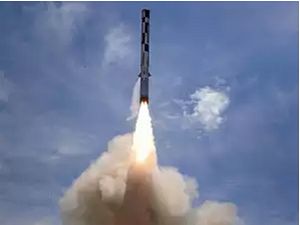The Indian Air Force (IAF) has conducted test firings of two BrahMos surface-to-surface supersonic cruise missile from Trak Island of the Andaman Nicobar Islands, an archipelagic island chain in the eastern Indian Ocean, on October 21 and 22, according to Indian officials.
The aim of the test launches was to validate the IAF’s ability to hit targets at a distance of up to 300 kilometers with “pinpoint accuracy,” said one official.
“Surface-surface missiles were fired by IAF at Trak Island in the Andaman Nicobar group of islands,” the official noted. “A direct hit on the target was achieved in both the cases. Firing of the missile has enhanced IAF’s capability to engage the grounds targets with pinpoint accuracy from a mobile platform.”
The missiles were fired in operational configuration “to assess mission readiness and swift deployment of the tactical missile over long distance,” according to the BrahMos Aerospace.
In late May, an Indian Army unit of the service’s Eastern Command also test launched a BrahMos surface-to-surface variant from Car Nicobar Island, the northernmost of the Nicobar Islands. In June, the Defense Research Development Organization (DRDO) test fired an anti-ship variant of the BrahMos at the Integrated Test Range (ITR) in Chandipur along the coast of Odisha
The BrahMos is a derivative of the Russian-made P-800 Oniks over-the-horizon supersonic anti-ship cruise missile with a range estimated at between 300 to 400 kilometers. It is thought to be capable of reaching top speeds of up to Mach 3.
The missile, named after the Brahmaputra River in India and the Moskva River in Russia, is the product of a joint venture between between India’s DRDO and Russian rocket design bureau NPO Mashinostroyeniya.
“India over the last few years has incrementally attempted to indigenize various components and subsystems of the BrahMos missile, including a new seeker and missile booster. An indigenous seeker and booster were both tested in 2018,” I noted previously. “Russia continues to supply the BrahMos’ ramjet propulsion system and seeker technology, while India provides the inertial navigation system and fire control system.”
The ground-launched surface-to-surface variant of the missile was first inducted into service with the Indian Army in 2007. The sea-launched version has also been deployed with the Indian Navy since 2014, while the air-launched variant is expected to become operational with the IAF by the end of this year.
To accelerate the production BrahMos missiles for the Indian military, Indian defense contractor and the missile’s manufacturer Larsen & Toubro opened up a new production line for BrahMos transport launch canisters in Vadodara in the western state of Gujarat in 2018.
DRDO has been working on an extended range variant of the BrahMos purportedly capable of hitting targets at distances of up to 800 kilometers.

































